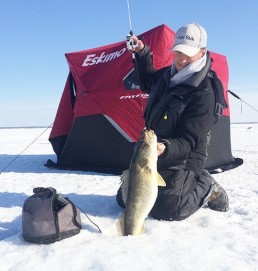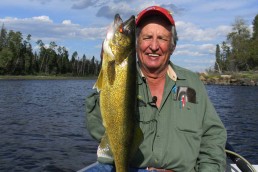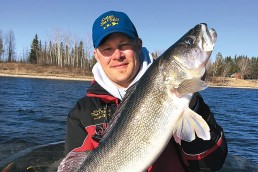Deadsticking Giant Erie Walleyes with the Pros
When I got the call from walleye pro Mike Gofron asking if I wanted to join him and Mark Brumbaugh and ice fish for Lake Erie walleyes, I didn’t hesitate one minute. I think my exact response was, “Do I need bait?”
Lake Erie has been known for terrific walleye fishing ever since I can remember, and long before that even. According to Mike, there is a seasonal pattern where the big female walleyes migrate from the deeper eastern basin to spawn in the shallower western basin. This migration happens during the ice season when Lake Erie is mostly frozen over. So catching big walleyes while ice fishing is a common occurrence.
Mike and Mark had our location all scouted out from previous outings so we loaded up the snowmobiles and ATVs and headed out in the early morning hours. Traveling almost a half hour on the lake, we eventually spotted a few shelters where Mike and Mark wanted to go. We arrived at our GPS coordinates and I began to set up our red Eskimo HUB ice shelter and drilled some holes.
Our location on Erie was a mud flat bottom in about 20 to 22 feet of water just off a nearby reef. The flat was a pretty good-sized flat, so the walleyes would be roaming. Our job would be to attract them and catch them.
Unless tip-up fishing, the majority of my ice fishing escapades have usually involved various jigging techniques in order to attract the fish and get them to bite. Constant movement of some kind was usually the strategy—where either rigorous movement up and down, or a jigging cadence of some sort was required to catch fish. On most occasions, letting the rod and bait remain motionless was sure to mean not catching fish, especially when fishing for perch, bluegills and whitefish.
Our technique at Erie would be two extremes—jigging and still fishing. Mike suggested the double barrel strategy where one rod would be for jigging and another would be set up as a “deadstick.” For those who aren’t familiar with the term, it is pretty self-explanatory. A deadstick is one that is left alone until a strike occurs. My two ice rods consisted of an Ugly Stik GX2 and an Abu Garcia Veritas 2.0.
The 26-inch Veritas 2.0 is a medium-light action rod that is lightweight and balanced with a softer action, so I chose that to be my jigging rod. The softer action of the Veritas made jigging the lures much smoother and didn’t cause a “snap” action that would cause the lure or jigging minnow to flip and snag the line. On the jigging rod, I used either a Custom Jigs and Spins “RPM” or a Lightning Spoon. The RPM is a new minnow-shaped body bait that gives a wide action. You use fast sweeps of the rod tip to get the bait to cover a wide area. As you lift up, the bait glides through the water column in one direction and when you let it drop, it turns and goes in another direction. It makes for a great search-style bait. There are other similar baits on the market, but a terrific feature to the RPM is that there is no front hook to snag the bottom of the ice hole as you land fish through the hole. It also features a rotating line-tie that reduces the much dreaded line twists. The Lightning Spoons are an older Custom Jigs lure but still a very productive lure. Because of the depth, I used a white-glow color that when doused with a flashlight, really illuminated in the water column, attracting the nearby walleye.
My second rod, the 28-inch Ugly Stik GX2 model, is a medium power rod, a bit stiffer along the backbone, but has a soft and flexible Ugly Stik patented clear tip. The soft tip would be extremely important to absorb the fight of a bigger walleye. The Ugly Stik deadstick rod was rigged with 4-pound Berkley ice line with a Custom Jigs Demon Jig tied on the end. The jig was then tipped with a small 3-inch emerald shiner. The jig and minnow was suspended about 5 to 6 feet off the bottom with a Venom Float. Venom Floats are ideal for ice fishing and are designed to give as little resistance to the bobber as possible. Many times a finicky fish will feel the weight of the bobber and then immediately spit the bait. The float eliminates this problem by establishing neutral buoyancy and by just barely suspending at or just below the water’s surface. Because it is neutrally buoyant, there is no drag on the bobber when pulled down, so the fish doesn’t feel anything but the bait.
The float consists of a plastic cylindrical tube that attaches easily to your fishing line. A foam insert is then twisted into the cylinder receiver tube to achieve the desired neutral buoyancy of your bait. What is ideal about the float is that one bobber/float can be used for a wide variety of jig weights and baits. If using a heavier jig or minnow, the foam insert can be pulled out creating an air pocket in the plastic body cavity, making it more buoyant for the heavier jigs. If using a lighter jig, the foam insert can be twisted into the tube’s cavity, creating a less buoyant float to use with lighter presentations. It is the most sensitive float on the market and is fully adjustable without modifying any components. It is also very fast and easy to use. Another excellent thing about using the float was that it served as a terrific bite indicator. Once the float/bobber went down the hole, all that was needed was to just grab the rod and set the hook.
The idea for the combination one-two punch of jigging and deadsticking was to lure the fish in with the jigging rod and then get them to bite the nearby deadstick minnow presentation. While we managed to catch fish with both presentations, the deadstick rod managed to catch more fish than jigging.
What I was completely amazed at was the actual size and quality of these fish. We managed to catch over a couple dozen walleyes with the smallest around 6 or 7 pounds, while the largest was close to 14 pounds!
The morning action was steady, with the afternoon lull setting in from about noon until 3:30 p.m. or so. But once the late afternoon/evening bite kicked in, the action was significantly upgraded. We kept a few of the smaller eater-sized fish and released the big spawners to help preserve the quality ice and open-water bite for years to come. I am hopeful to return again this coming season and make Lake Erie one of my annual ice trips.
MWO
SHARE THIS POST
Did you enjoy this post?
You can be among the first to get the latest info on where to go, what to use and how to use it!
Larry Ladowski
Larry Ladowski is a regular host on MidWest Outdoors TV and has been writing for MidWest Outdoors magazine for more than 25 years. Ladowski enjoys any time on the water and in the field, no matter where it happens to be and no matter what species he is fishing or hunting.




